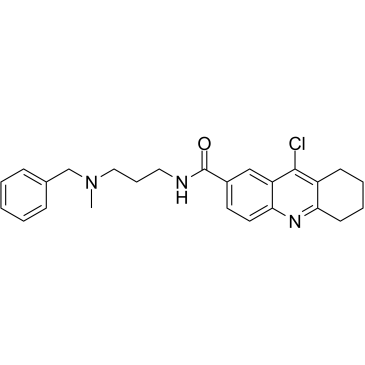HBX 19818 |
| Catalog No.GC36211 |
HBX 19818 es un inhibidor especÍfico de la proteasa 7 especÍfica de ubiquitina (USP7), con una IC50 de 28,1 μM.
Products are for research use only. Not for human use. We do not sell to patients.

Cas No.: 1426944-49-1
Sample solution is provided at 25 µL, 10mM.
HBX 19818 is a specific inhibitor of ubiquitin-specific protease 7 (USP7), with an IC50 of 28.1 μM. IC50: 28.1 μM (USP7)[1]
HBX 19818 is an inhibitor of USP7, with an IC50 of 28.1 μM. HBX 19818 shows no effects on USP8, USP5, USP10, CYLD, UCH-L1, UCH-L3 or on SENP1, a SUMO protease, with IC50s of > 200 μM. HBX 19818 selectively inhibits USP7 with IC50 of ∼6 μM in in human cancer cells. In addition, HBX 19818 (1.5, 4, 12, 36, or 100 μM) inhibits USP7 deubiquitination of polyubiquitinated p53. HBX 19818 (30 μM) also causes significantly higher levels of Mdm2 polyubiquitinated forms in USP7-overproducing HEK293 cells than those in DMSO-treated control cells. HBX 19818 inhibits HCT116 proliferation in a dose-dependent manner, with an IC50 of ∼2 μM[1].
[1]. Reverdy C, et al. Discovery of specific inhibitors of human USP7/HAUSP deubiquitinating enzyme. Chem Biol. 2012 Apr 20;19(4):467-77.
Average Rating: 5 (Based on Reviews and 1 reference(s) in Google Scholar.)
GLPBIO products are for RESEARCH USE ONLY. Please make sure your review or question is research based.
Required fields are marked with *




















